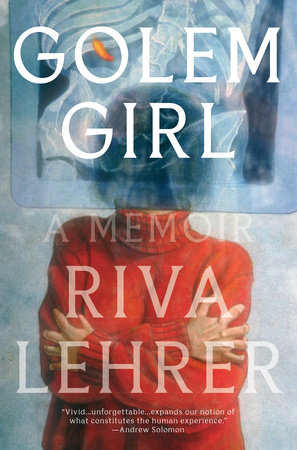Golem Girl
A Memoir
Riva Lehrer
Paperback
October 26, 2021 | ISBN 9781984820327
AmazonBarnes & NobleBooks A MillionBookshop.orgHudson BooksellersPowell'sTargetWalmart
Hardcover
October 6, 2020 | ISBN 9781984820303
AmazonBarnes & NobleBooks A MillionBookshop.orgHudson BooksellersPowell'sTargetWalmart
Ebook
October 6, 2020 | ISBN 9781984820310
AmazonApple BooksBarnes & NobleBooks A MillionGoogle Play StoreKobo
About the Book
“Golem Girl is luminous; a profound portrait of the artist as a young—and mature—woman; an unflinching social history of disability over the last six decades; and a hymn to life, love, family, and spirit.”—David Mitchell, author of Cloud Atlas
WINNER OF THE BARBELLION PRIZE • FINALIST FOR THE NATIONAL BOOK CRITICS CIRCLE AWARD FOR AUTOBIOGRAPHY • NAMED ONE OF THE BEST BOOKS OF THE YEAR BY KIRKUS REVIEWS
What do we sacrifice in the pursuit of normalcy? And what becomes possible when we embrace monstrosity? Can we envision a world that sees impossible creatures?
In 1958, amongst the children born with spina bifida is Riva Lehrer. At the time, most such children are not expected to survive. Her parents and doctors are determined to "fix" her, sending the message over and over again that she is broken. That she will never have a job, a romantic relationship, or an independent life. Enduring countless medical interventions, Riva tries her best to be a good girl and a good patient in the quest to be cured.
Everything changes when, as an adult, Riva is invited to join a group of artists, writers, and performers who are building Disability Culture. Their work is daring, edgy, funny, and dark—it rejects tropes that define disabled people as pathetic, frightening, or worthless. They insist that disability is an opportunity for creativity and resistance. Emboldened, Riva asks if she can paint their portraits—inventing an intimate and collaborative process that will transform the way she sees herself, others, and the world. Each portrait story begins to transform the myths she’s been told her whole life about her body, her sexuality, and other measures of normal.
Written with the vivid, cinematic prose of a visual artist, and the love and playfulness that defines all of Riva's work, Golem Girl is an extraordinary story of tenacity and creativity. With the author's magnificent portraits featured throughout, this memoir invites us to stretch ourselves toward a world where bodies flow between all possible forms of what it is to be human.
“Not your typical memoir about ‘what it’s like to be disabled in a non-disabled world’ . . . Lehrer tells her stories about becoming the monster she was always meant to be: glorious, defiant, unbound, and voracious. Read it!”—Alice Wong, founder and director, Disability Visibility Project




